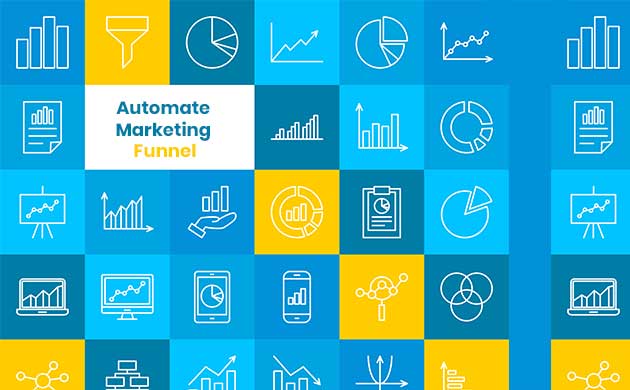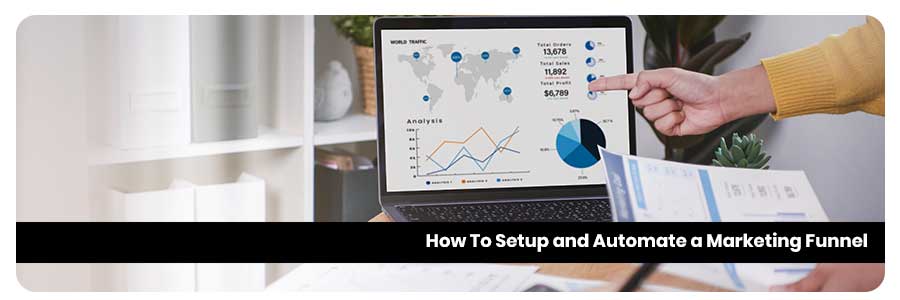How To Setup and Automate a Marketing Funnel
Do you run social media ads? If you do, how are you managing your sales funnel?
Setting up a quality marketing funnel is the key to automating a steady flow of qualified leads, special when your digital marketing campaign is on. Find out all you need to know about building a successful marketing funnel. In this post, we’ll teach you how to accomplish it and more –
- What is a marketing funnel, and what are some examples?
- The AIDA funnel (plus the five stages of a marketing funnel)
- How to put each level of your funnel together
- Qualifying leads you can get in your funnel
What is a marketing funnel?
A marketing funnel, also known as a purchase funnel, is a company’s blueprint for guiding potential customers from their initial contact with the brand to becoming paying customers. Paid commercials, social media, SEO, content marketing, and a variety of other channels are frequently included in this roadmap.
While the concept is straightforward, marketing funnels can be difficult to understand for a variety of reasons, including:
- Your consumers may have a variety of problems. (A doctor seeking a survey tool may have different requirements than a teacher seeking a survey instrument)
- Each customer has a distinct level of awareness (some have heard of your brand and are looking for alternatives, while others are unaware that alternatives exist)
- There are numerous marketing avenues from which to pick (paid ads, SEO, etc.)
With so many elements to consider, it’s easy to see how constructing a marketing funnel may rapidly become overwhelming. Even if you’ve never sat down to properly build a marketing funnel, you very certainly already have one. Here’s an illustration of how a marketing funnel might look:
Most businesses, on the other hand, have many funnels. A business may acquire prospects through paid ads, or another channel in addition to blog postings. We’ll go through how to decide which channel to focus on later, but don’t assume there’s only one option to produce new leads right now.
What does a marketing funnel look like?
- Podcast Ad > Blog Post > Conversion
- Facebook Ad > Landing Page > Conversion
- Blog Post > Email List > Conversion
- Influencer Social Post > Landing Page > Conversion
Whether you realize it or not, you have a marketing funnel if people are buying your product or service online. Keep in mind that, while your marketing plan may appear to be straightforward on paper, it is not necessarily so in practice. As customers progress through your marketing funnel, regressions and jumps are common. Even though Customer A and Customer B both entered through content marketing, their customer journeys were highly distinct, and they had very different experiences with the buying funnel:
One of the reasons Single Grain’s marketing approach is to establish an omni channel marketing plan is that you never know where you’ll find new customers. Cross-sells and upsells can be added to your funnel even after a consumer has made a purchase. Now that you understand what a funnel is and how it works, you’re probably wondering how to create one that employs the most appropriate channels for your business while remaining simple.
How Does It Work: The Funnel Stage
If you’ve ever used a paper funnel at the gas station to pour oil into your car’s oil reservoir instead of all over the engine, you have a basic understanding of how a funnel works. A marketing funnel works in stages, from the widest area at the top (Top of Funnel) that attracts many individuals, to the smaller section in the center (Middle of Funnel), and finally to the even narrower section at the bottom (Bottom of Funnel) that attracts serious buyers:
That’s why, when it comes to creating a marketing or sales funnel, the most important thing to remember is to think about it from the customer’s perspective. This will save you a lot of time and aggravation. Let’s take a look at the different stages of the marketing funnel that clients go through.
Stage 1: Recognize the problem
The first step in the buying process is to recognize that you have a problem. Why would you buy a remedy for a problem you don’t even realize you have? You could have gum disease, but if you don’t notice or feel anything unusual in your mouth, it’s unlikely that you’ll go online to look for it. If, on the other hand, your furnace breaks down in the dead of winter, you’ll immediately recognize a problem and go on to the next step in the purchase process (information search). You might do some research, but because your problem is so urgent, you won’t waste much time. Other items or services will necessitate a greater level of education. Purchasing pharmaceutical medicine is an example. A person may detect a bodily symptom (“issue”) in this scenario, but it may take some time for them to act and seek a solution.
Stage 2: Information Gathering
Recognizing a problem or need is the first step in the funnel, which leads to a search for further information and leads to the second stage. Depending on the magnitude and scope of the transaction, different tactics are utilized to obtain information. Recognizing that you’re hungry, for example, may prompt you to conduct a quick Yelp search for nearby restaurants. On the other hand, deciding which supplier to engage in installing a new in-ground pool at your property will require some web research, phone calls, reading customer reviews, visiting showrooms, and speaking with salespeople. According to Trust Radius, over 33% of consumers spent more time researching products before buying in 2021 than they did the previous year, indicating that this stage of the funnel is becoming more in-depth. People aren’t searching for commercial content at this point; they want to learn more about possible solutions to their problems.
Stage 3: Alternatives Evaluation
Customers will compare the choices discussed in your article or ad once they are aware of a solution. The amount of time invested in this stage varies depending on the type of purchase being considered. Choosing a restaurant may be as simple as deciding, “Well, I’m in the mood for Chinese food tonight, not Mexican.” Assume, however, that the customer is looking into marketing automation systems to help them optimize the sales funnel they’ve built. Because these programs can cost up to $1,500 per month, they’ll almost certainly be subjected to a far more rigorous review.
They may request free trials of the various systems they’re considering, participate in online demonstrations with personnel from each company, or watch training videos to get a sense of how each system will function. If you manage an accounting firm, your customers are probably comparing multiple service providers at this point. They may require tools such as pricing guides (to determine ballpark charges), how to assess the landscape of accounting services (e.g., whether to engage a single accountant, an agency, etc.), or how to select an accountant.
If you manage a marketing services company, you might develop content on the following topics:
- Pricing guides for agencies
- If a business should outsource or hire in-house.
- How to pick a marketing firm
We’ve established non-promotional, instructive material tools for our readers who are considering employing digital marketing who have reached this stage are more committed to completing a purchase than those who are only performing preliminary research. As a result, if your resources are limited, you don’t have to start at the top of the funnel. Instead, you can start by focusing on bottom-of-the-funnel prospects to obtain the most conversions with the least amount of work to set How To Setup and Automate a Marketing Funnel
Stage 4: Making a Purchase
The buying decision follows logically from the previous three stages. The potential consumer has identified a problem, researched their options, and chosen which is best for them… They’re getting ready to take out their wallets right now. Optimizing your website for conversions (CRO) is a great approach to boost sales at this point. You can also provide risk-free trials, money-back guarantees, and other similar incentives to entice customers to buy your product or service.
Stage 5: Post-Purchase Behavior
There is one more thing! Just because a customer makes a purchase doesn’t mean the journey is ended. It’s just as essential as what occurs after the sale. If your new customers are welcomed with a thoughtful personalized attention, a planned onboarding process, and all of the resources they need to successfully utilize your product, they are more likely to become loyal customers who suggest you to friends and colleagues. Furthermore, when people are confident in themselves, they are more inclined to share their enjoyment with others through suggestions and product endorsements.
If your new consumers are dissatisfied with their purchase, they are more likely to ask for refunds, leave unfavorable reviews, and recommend that others in their social circles buy from your competitors.
- Apart from delivering a fantastic product, there isn’t much information you can create to help promote a nice post-purchase experience. Post-purchase behavior will take care of itself if you have an excellent product that answers a problem.
- There are also some steps you may take to encourage better post-purchase behavior. You may, for example, provide FAQ content, make customer service more accessible, or ask for feedback on the purchasing process.
How To Setup and Automate a Marketing Funnel
Conclusion
When you run social media campaigns, your sales funnel will keep growing at one stage it will be difficult to manage it all. Get in touch with a professional digital marketing expert and get your marketing funnel managed on a regular basis.




Leave a Reply